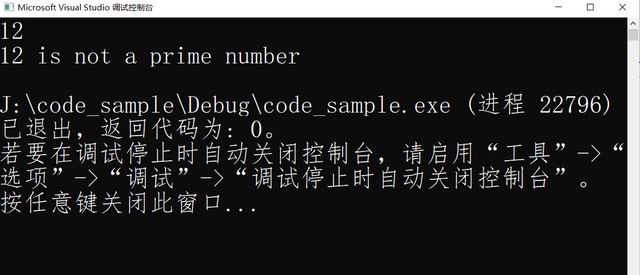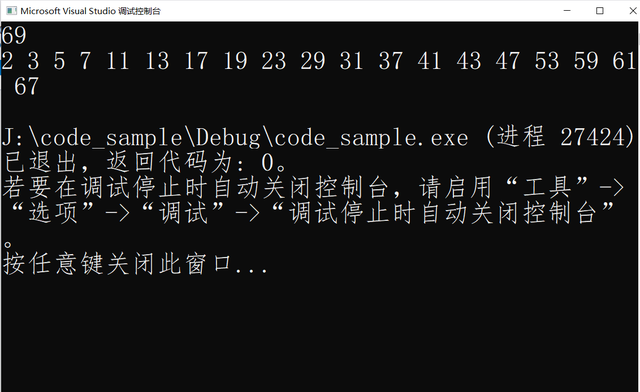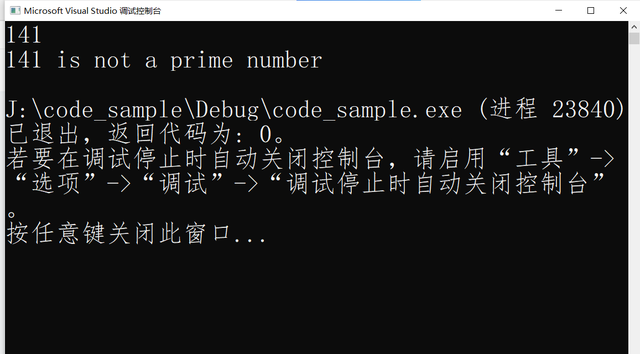🚀欢迎互三!
目录
在计算机程序中,可以使用以下几种方法来判断一个数是否为素数:
1、暴力法:
遍历 2 到根号 n 的数,判断 n 是否能被它们整除。如果 n 能被任意一个数整除,则 n 不是素数;否则 n 是素数。下面是一个使用暴力法判断素数的 C++ 代码示例:
#include <iostream> #include <cmath> using namespace std; bool is_prime(int n) { if (n <= 1) return false; for (int i = 2; i <= sqrt(n); i++) { if (n % i == 0) return false; } return true; } int main() { int n; cin >> n; if (is_prime(n)) { cout << n << " is a prime number" << endl; } else { cout << n << " is not a prime number" << endl; } return 0; }
运行结果
2、线性筛法:
使用线性时间复杂度来预处理出小于等于给定数 n 的所有素数,然后判断 n 是否在素数列表中。下面是使用线性筛法判断素数的 C++ 代码示例:
#include <iostream> #include <cmath> using namespace std; #include <iostream> #include <cstring> using namespace std; const int N = 1000000; bool isPrime[N + 5]; // isPrime[i]表示数字i是否是素数 void linear_sieve(int n) { memset(isPrime, true, sizeof(isPrime)); // 初始化,假设所有数字都是素数 isPrime[0] = isPrime[1] = false; // 0和1不是素数 for (int i = 2; i <= n; i++) { // 从2开始枚举 if (isPrime[i]) { // 如果i是素数 for (int j = i * i; j <= n; j += i) { // 将i的倍数全部标记为合数 isPrime[j] = false; } } } } int main() { int n; cin >> n; linear_sieve(n); // 求出小于等于n的素数 for (int i = 0; i <= n; i++) { if (isPrime[i]) { cout << i << " "; } } cout << endl; return 0; }
运行结果
3、类欧几里得算法:
在数论中,可以使用类欧几里得算法来判断一个数是否为素数。根据费马小定理(Fermat's little theorem),对于所有大于 2 的正整数 n,如果存在一个数 a,使得 a^(n-1) ≡ 1 (mod n),则 n 为素数。
因此,我们可以使用类欧几里得算法来快速计算 a^(n-1) mod n 的值,如果结果为 1,则 n 为素数;否则 n 不是素数。下面是使用类欧几里得算法判断素数的 C++ 代码示例:
#include <iostream> #include <cmath> using namespace std; int mod_pow(int a, int b, int m) { int res = 1; a %= m; while (b > 0) { if (b & 1) res = res * a % m; a = a * a % m; b >>= 1; } return res; } bool is_prime(int n) { if (n <= 1) return false; if (n <= 3) return true; int d = n - 1; while (d % 2 == 0) d /= 2; for (int a : {2, 3, 5, 7, 11, 13, 17, 19, 23, 29, 31, 37}) { if (n == a) return true; if (mod_pow(a, d, n) == 1) continue; int r = d; while (r < n - 1 && mod_pow(a, r, n) != n - 1) r *= 2; if (r >= n - 1) return false; } return true; } int main() { int n; cin >> n; if (is_prime(n)) { cout << n << " is a prime number" << endl; } else { cout << n << " is not a prime number" << endl; } return 0; }
运行结果
4、埃氏筛法:
埃氏筛法(Sieve of Eratosthenes)是一种用于预处理小于等于给定数 n 的所有素数的算法。该算法的基本思想是,使用一个布尔数组来存储小于等于 n 的数是否为素数,然后逐个遍历这些数,并根据它们是否为素数来更新数组中其他数的状态。下面是使用埃氏筛法判断素数的 C++ 代码示例:
#include <iostream> #include <cmath> using namespace std; int mod_pow(int a, int b, int m) { int res = 1; a %= m; while (b > 0) { if (b & 1) res = res * a % m; a = a * a % m; #include <iostream> #include <cstring> #include <cmath> using namespace std; const int N = 1000000; bool is_prime[N + 5]; void sieve() { memset(is_prime, true, sizeof(is_prime)); is_prime[0] = is_prime[1] = false; for (int i = 2; i <= N; i++) { if (is_prime[i]) { for (int j = 2 * i; j <= N; j += i) { is_prime[j] = false; } } } } bool check_prime(int n) { return is_prime[n]; } int main() { sieve(); int n; cin >> n; if (check_prime(n)) { cout << n << " is a prime number" << endl; } else { cout << n << " is not a prime number" << endl; } return 0; }
运行结果
以上四种方法都可以判断素数,大家学会了吗?


























 5526
5526

 被折叠的 条评论
为什么被折叠?
被折叠的 条评论
为什么被折叠?








